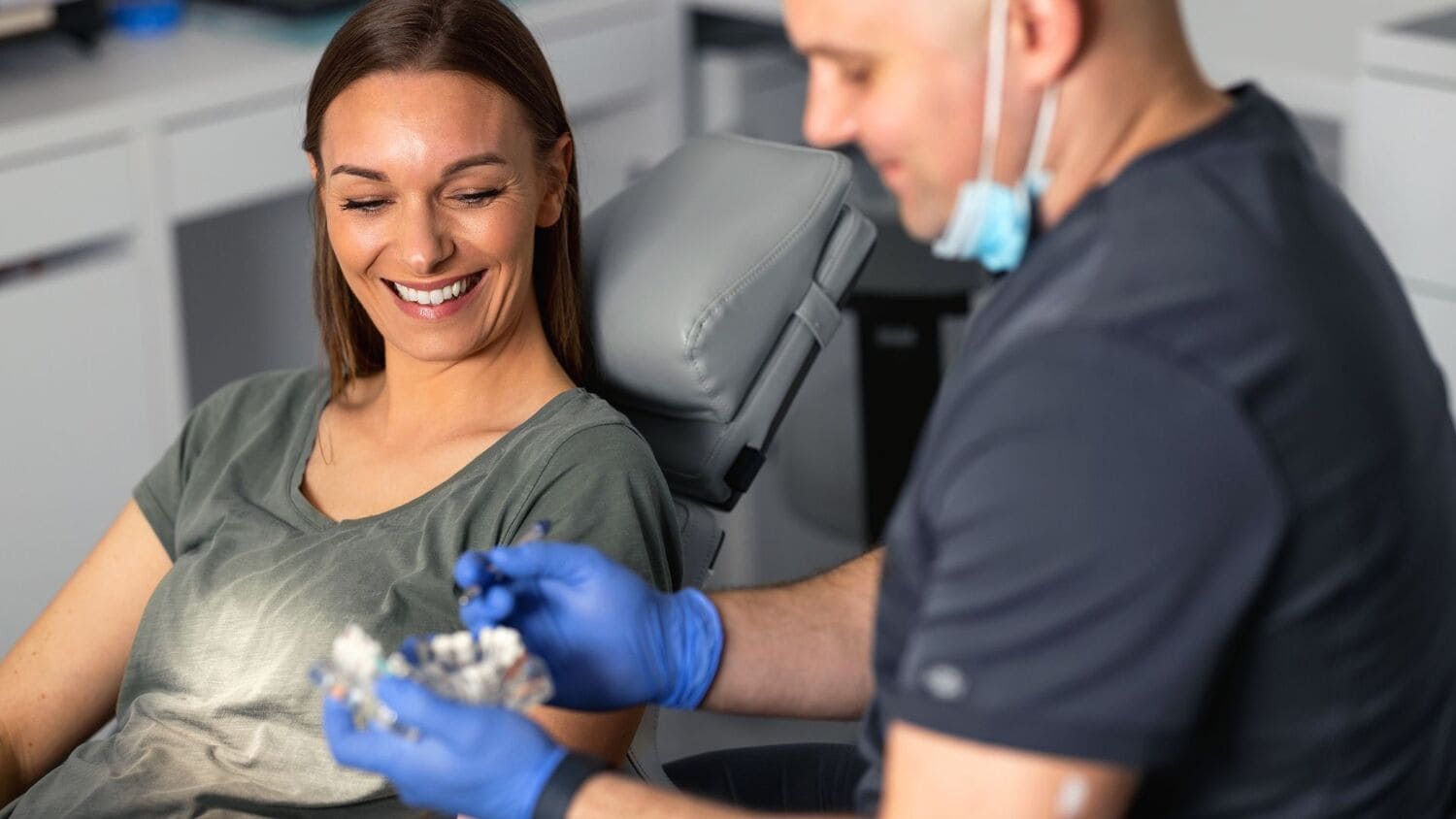Most people think orthodontists just straighten teeth with braces. That’s part of the job, but it’s not the whole story. If you’ve ever wondered what do orthodontist do, the answer goes far beyond metal brackets and wires.
Orthodontists are trained to fix more than crooked teeth. They help with bite problems, jaw alignment, facial balance, and even some breathing issues. Their work often starts when kids are young and continues through adulthood, helping people chew better, speak more clearly, and feel good about their smile.
This article breaks down everything orthodontists actually do, including when you might need one and how their care supports your long-term oral health. Whether you’re a parent thinking about your child’s teeth or an adult curious about improving your own smile, you’ll learn exactly how orthodontists make a difference and not just in how you look.
Education & Expertise: What Sets Orthodontists Apart
Orthodontists don’t just wake up one day and start putting on braces. First, they go through dental school, just like regular dentists. Then, they take on another two to three years of extra training focused only on straightening teeth, fixing bites, and working with jaw and facial structure.
Their job is about more than just getting teeth in line. They look at how the top and bottom teeth fit together, how the jaw grows, and how all of that affects your face and even how you breathe. This extra training gives them the skills to treat kids whose mouths are still developing and adults with more complex issues.
That’s why orthodontists are the go-to experts when teeth and jaws need more than just cleaning or fillings. They bring a deeper level of care that helps everything work better, not just look better.
When Should You See an Orthodontist? Key Indicators
A lot of people ask, what do orthodontist do besides braces but a better question might be when should someone actually see one? It’s not just about crooked teeth.
Here are a few signs that could mean it’s time:
- Baby teeth falling out too early or too late
- Trouble biting or chewing food
- Teeth that look crowded or have large gaps
- Jaws that pop, shift, or feel sore
The American Association of Orthodontists recommends that kids have their first check-up by age 7. That’s because some bite or jaw problems are easier to fix while the mouth is still growing. Catching things early can make future treatment simpler or sometimes even prevent it altogether.
And for teens or adults, it’s never too late. If something feels off with your bite or smile, an orthodontist in mesa can help figure out what’s going on.
Diagnostics: Advanced Tools Behind Treatment Plans
When figuring out what’s going on with your teeth or jaw, orthodontists don’t guess. They use special tools to see exactly what’s happening beneath the surface. That includes digital scans, bite tests, CBCT imaging, and 3D impressions. These tools help show things that can’t be seen just by looking in your mouth.
With the right scans, orthodontists can catch problems early, like crowded teeth, jaw misalignment, or even issues that affect breathing. That’s a big part of what do orthodontist do behind the scenes.
Every smile is different, so a one-size-fits-all approach doesn’t work. These advanced tools help orthodontists create a treatment plan that’s made just for you. Whether it’s braces in Mesa, aligners, or another option, the goal is to fix the root of the issue, not just the surface.
Functional Bite Correction: More Than Cosmetic Fixes
Fixing how teeth line up isn’t just about looks. It also plays a big role in how your mouth works every day. Orthodontists treat several bite problems, like:
- Overbite – top teeth stick out too far
- Underbite – bottom teeth sit in front of the top
- Crossbite – teeth don’t match up from side to side
- Open bite – front teeth don’t touch when you bite down
These issues can affect how you chew, how clearly you speak, and even cause enamel to wear down too fast. In some cases, they can also lead to jaw pain or TMJ problems.
Part of what do orthodontist do is fix these bite problems using tools like elastics, bite correctors, or expanders. These appliances gently guide your teeth and jaws into a better position, helping everything work the way it should, not just look better in photos.
Early Interceptive Treatment in Children
Some orthodontic problems are easier to fix before all the adult teeth come in. That’s why orthodontists sometimes start what’s called Phase I treatment for kids around age 7 to 10. It’s a way to guide how the teeth and jaws grow while the mouth is still developing.
This early care might involve using simple appliances like expanders, spacers, or partial braces. These tools can help create more room, fix bite problems, and prevent teeth from getting too crowded later on.
One important part of what orthodontist do is try to avoid more serious work down the road. By stepping in early, they may reduce the need for pulling teeth or using full braces later. It’s about making future treatment faster, easier, and less invasive whenever possible.
Facial Symmetry & Jaw Alignment: Orthodontics and Aesthetics
Orthodontics doesn’t just straighten teeth; it can also improve the balance of your face. When jaws are too far forward, too far back, or uneven, it can affect how someone looks, talks, eats, and even breathes.
One part of what do orthodontist do is guide jaw growth in kids or teens, often using expanders or other appliances to help everything develop in the right direction. When the jaw is in a better position, the face often looks more balanced and natural.
For adults, if the bones are already set, more advanced treatment like orthognathic surgery may be needed. In those cases, the orthodontist works with a surgeon to correct jaw position and improve how everything functions and looks. It’s not just about beauty; it’s about comfort and health too.
Airway-Focused Orthodontics: Breathing and Sleep Health
Breathing through the nose is important for sleep, focus, and overall health but not everyone does it naturally. Some kids and adults breathe through their mouths without realizing it, which can be linked to narrow jaws, a high palate, or tongue posture issues.
Part of what orthodontists do is check for these signs during an exam. If they notice a narrow upper jaw, they might use an expander to gently widen it, making more room for better airflow through the nose.
In more complex cases like sleep apnea or serious snoring, orthodontists often work with sleep doctors or ENT specialists. Together, they find solutions that support healthier breathing, especially at night.
Retention: Maintaining Long-Term Results
Finishing braces or aligners doesn’t mean the work is over. Teeth can shift over time, which is why retainers are a key part of keeping your results in place.
Orthodontists usually provide one of two types: fixed retainers (a small wire behind the teeth) or removable retainers (a clear tray you wear at night). The type depends on your case and how much movement needs to be controlled.
Part of what orthodontists do after treatment is check that everything stays in the right spot. Regular check-ins help prevent relapse and keep your smile looking and working its best.
Treating Adults: A Different Set of Considerations
More adults are getting orthodontic treatment today, sometimes for a better smile, sometimes for a healthier bite. And the good news is, it’s never too late to get started.
But adult treatment isn’t always the same as it is for kids or teens. Bone is harder, gums may be more sensitive, and some adults have crowns, missing teeth, or past dental work to consider. That’s why orthodontists take a closer look at things like bone density and gum health before starting.
Part of what orthodontist do for adults is build custom plans using tools like clear aligners, behind-the-teeth (lingual) braces, or even a mix of both. These options work around existing dental work and help fix complex issues, without affecting daily life too much.
Complex Cases: Surgical and Multidisciplinary Care
Some dental problems are more than braces alone can fix. Things like impacted teeth, serious jaw misalignment, or injury-related issues often need a team approach. That’s where orthodontists step in to guide the process.
Part of what orthodontist do in complex cases is work with other specialists like oral surgeons for jaw surgery, periodontists for gum concerns, or prosthodontists for tooth restoration. Everyone has a role in making sure the final result works and looks right.
A common example is jaw surgery. Before the surgery, the orthodontist may move the teeth into better positions so the surgeon can shift the jaw correctly. This teamwork helps patients get the best long-term outcome.
TMJ Disorders and Bite-Related Pain Management
Jaw pain, clicking, or trouble opening your mouth wide could be signs of a TMJ disorder. TMJ stands for temporomandibular joint the hinge that helps your jaw move. When it’s not working right, it can cause daily discomfort.
Orthodontists check if your bite or jaw alignment is adding stress to that joint. Part of what do orthodontist do is help reduce this pressure using things like bite adjustments, splints, or a custom treatment plan.
The goal is to ease the pain, improve movement, and prevent the issue from getting worse over time.
Orthodontic Solutions for Sleep Apnea
Sleep apnea isn’t just about snoring, it can affect how well you sleep and how your body functions during the day. In some mild-to-moderate cases, it’s linked to the way your jaw sits and how it affects your airway.
Part of what do orthodontist do is offer solutions like oral appliance therapy. These custom devices gently shift the lower jaw forward while you sleep, keeping the airway more open.
This can lead to better sleep, less snoring, and fewer health risks tied to poor breathing at night, like fatigue, headaches, or heart strain.
Digital Tools & Technology: Modernizing Orthodontics
Orthodontic care has come a long way thanks to new technology. Instead of messy molds, many offices now use digital impressions to scan your teeth quickly and comfortably. Some orthodontists also use AI-based simulations to show how your smile could change before treatment even starts.
3D-printed aligners and virtual check-ins help make the process faster and more convenient. These tools save time, reduce in-person visits, and make sure your treatment stays on track.
A big part of what do orthodontist do today is use these tools to create more accurate, comfortable, and efficient care for every patient.
Emotional and Psychological Impact of Orthodontic Treatment
Orthodontic treatment doesn’t just change your smile, it can change how you feel about yourself. When teeth are straighter and bites are healthier, many people feel more confident speaking, smiling, or even just being in photos.
This is especially true for teens, who may feel more at ease in school or social settings after treatment. Adults often report feeling more professional and comfortable in work environments too.
One part of what do orthodontist do that’s often overlooked is the emotional side. A better smile can make a big difference in how people see themselves and interact with others.
Conclusion: A Full-Scope Health Partner, Not Just a Smile Fixer
Orthodontists do more than make smiles look better; they help improve how your mouth works, how your face develops, and even how you breathe and sleep. From early treatment in kids to complex adult care, their work touches nearly every part of oral and facial health.
If you’ve ever asked what do orthodontist do, the answer includes way more than just braces. They use advanced tools, work with other specialists, and create personalized plans to support long-term health and function, not just short-term results.
Getting a consultation doesn’t mean you’ll need braces right away. It just means you’re taking a smart step to protect your dental health and catch any issues early. Kids, teens, and adults can all benefit from an orthodontist’s care at the right time.
It’s not just about looks, it’s about feeling better, functioning better, and staying healthy for the long run.
Take the Next Step with Nathan Davis Orthodontics
If you think your bite feels off, your child’s teeth are shifting strangely, or you’ve simply been wondering what an orthodontist could help with, it’s a good time to get answers. At Nathan Davis Orthodontics, we take the time to look at the full picture function, comfort, and confidence.
Our team works with patients of all ages using the latest tools and treatment options, always focused on long-term health and results that feel just as good as they look.
No pressure. Just a thoughtful, expert evaluation built around your needs.
Book your consultation today and get the clarity you’ve been looking for.
FAQs
What does an orthodontist do besides braces?
Orthodontists do more than just straighten teeth with braces. They also correct bite problems, improve jaw alignment, guide facial growth, and even help with breathing issues. Their care supports both oral health and overall well-being.
When should a child first see an orthodontist?
The American Association of Orthodontists recommends a first check-up by age 7. Early visits help detect bite or jaw problems while the mouth is still developing, which can make future treatment easier or even prevent more serious issues.
Can adults benefit from orthodontic treatment?
Yes, orthodontic treatment isn’t just for kids or teens. Many adults choose braces or aligners to improve their bite, fix jaw problems, or simply achieve a more confident smile. Treatment plans are personalized to work around existing dental work.
How do orthodontists use technology in treatment?
Modern orthodontists use digital scans, 3D imaging, and even AI-based simulations to create precise treatment plans. These tools improve comfort, reduce guesswork, and help patients see how their smile will change before treatment begins.
Why is retention important after braces or aligners?
After orthodontic treatment, teeth can shift back if not maintained. That’s why retainers are essential—they keep your teeth in place and protect your results. Regular check-ins with your orthodontist ensure your smile stays healthy and aligned long-term.


